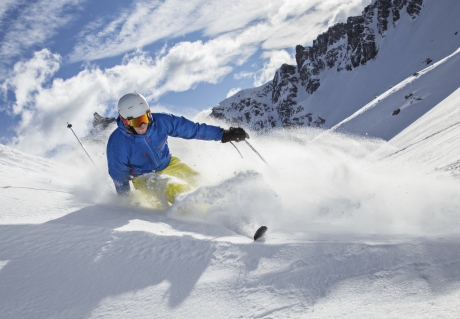Many parents worry at least a little every time they see their child or young teen head off for the slopes. With a little advice, you can help you’re your winter athlete excel and enjoy the sports they love, including skiing and snowboarding.
Snow sports are some of the most popular winter sports among young athletes in our area, and we take pride in helping our patients stay healthy and active on the mountain. We also understand the importance of safely getting your young athlete back on the slopes as soon as possible.
Skiing and snowboarding are extremely physically demanding sports, requiring high endurance and core strength, no matter what the age of the athlete. Athletes often snowboard or ski for an entire day, sometimes back-to-back days, which greatly fatigues the body and increases the risk of injury.
Skiing and snowboarding result in a large variety of non-contact injuries, many of which can be prevented. These types of non-contact injuries usually involve the muscles, joints and ligaments of the knee and ankle due to the high degree of leg movement involved in snow sports.
The most common ski injuries include knee, ankle and thumb sprains. Injuries to the wrist, shoulder and head are more commonly seen in snowboarding. Wrist fractures commonly happen when the hands and arms are used to brace falls.
Both skiing and snowboarding can result in the following injuries:
- Arm and leg fractures
- Concussions, usually caused from falls on ice, collisions with other athletes, trees or the ground
- Knee injuries such as medial collateral ligament (MCL) and anterior cruciate ligament (ACL) tears, with MCL strains being the most common knee injury
- Ankle sprains
- Muscle strains of the lower extremities (legs) and back
Tips for Injury Prevention
Regardless of a young athlete’s ability, wearing appropriate protective equipment is the best defense against injury. Skiers and snowboarders should wear helmets to prevent head injury, goggles to prevent eye injury, and wrist guards. Snowboarders who wear wrist guards have a 40% less chance of a wrist fracture.
More aggressive skiers and boarders who spend most of their time in the terrain parks or on extreme terrain should consider spine and body protection.
Snow sports are strenuous activities with heavy demands on the muscles, tendons, ligaments and bones of the body. It is important that young athletes are in good physical and cardiovascular condition prior to attempting these activities. We recommend that beginners take professional lessons to develop skills and learn critical safety tips, such as how to take a fall on the snow.
Injuries Are Most Likely To Occur On:
- The first day of skiing
- In the early morning when the skier is not warmed up
- In the late morning and late in the day when fatigue is a factor
- At the end of the week when the cumulative effects of the vacation make the skier tired
- Hard packed snow conditions can lead to impact injuries due to high speeds of the skier and the hard landing surface
General Injury Prevention:
- Prepare for the season and get in shape
- Get your equipment checked at a certified shop
- Self-release your bindings each day you ski
- Warm up and stretch before skiing
- Don’t ski while intoxicated
- Wear a helmet!
- Snowboarders: Wear wrist guards!

